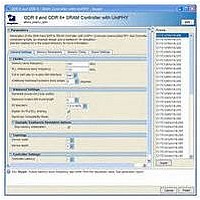IPR-QDRII/UNI Altera, IPR-QDRII/UNI Datasheet - Page 32

IPR-QDRII/UNI
Manufacturer Part Number
IPR-QDRII/UNI
Description
IP CORE Renewal Of IP-QDRII/UNI
Manufacturer
Altera
Datasheet
1.IP-QDRIIUNI.pdf
(74 pages)
Specifications of IPR-QDRII/UNI
Software Application
IP CORE, Memory Controllers, SRAM
Supported Families
Arria II GX, HardCopy III, Stratix III, Stratix IV
Core Architecture
FPGA
Core Sub-architecture
Arria, HardCopy, Stratix
Rohs Compliant
NA
Lead Free Status / RoHS Status
na
3–4
Board Settings
External Memory Interface Handbook Volume 3
Section III. QDR II and QDR II+ SRAM Controller with UniPHY User Guide
Intersymbol Interference
Board Skews
The Board Settings tab allows you to enter values derived from board simulation.
Intersymbol interference (ISI), occurs when a signal is distorted due to the
interference of one symbol with subsequent symbols. Typically, ISI is greater at device
depths greater than 1 because there are multiple stubs causing reflections. The
advanced I/O timing analysis capabilities of the Quartus II software already includes
ISI effects for device depth of 1.
Table 3–7
Table 3–7. Intersymbol Interference Settings
Skews between PCB traces can reduce timing margins.
Table 3–8
Table 3–8. Board Skews Settings (Part 1 of 2) (Part 1 of 2)
Address/command eye reduction
(setup)
Address/command eye reduction
(hold)
D eye reduction
Delta K arrival time
Maximum delay difference between
devices
Maximum skew within write data
group (ie, K group)
Maximun slkew within read data
group (ie, CQ group)
Maximum skew between CQ groups
describes the intersymbol interference settings.
describes the board skew settings.
Parameter
Parameter
The reduction in the eye diagram on the setup side (or left
side of the eye) due to ISI on the address/command signals
compared to a case where there is no ISI.
The reduction in the eye diagram on the hold side (or right
side of the eye) due to ISI on the address/command signals
compared to a case where there is no ISI.
The total reduction in the eye diagram due to ISI on DQ
signals compared to a case where there is no ISI. (It is
assumed that the ISI reduces the eye width symmetrically
on the left and right sides of the eye.)
The increase in variation on the range of arrival times of
DQS compared to a case when there is no ISI. (It is
assumed that the ISI causes DQS to further vary
symmetrically to the left and right.)
The maximun delay difference of data signals between
devices. For example, in a two-device configuration there is
greater propagation delay for data signals going to and
returning from the furthest device relative to the nearest
device.
The maximum skew between D and BWS signals
referenced by a common K signal.
The maximum skew between Q signals referenced by a
common CQ signal.
The maximum skew between CQ signals of different read
data groups.
Description
Description
December 2010 Altera Corporation
Chapter 3: Parameter Settings
Board Settings













